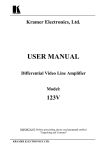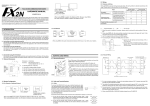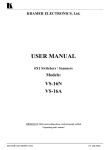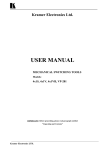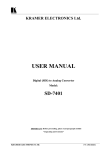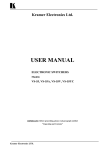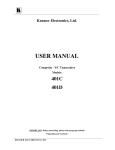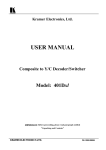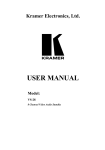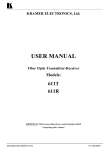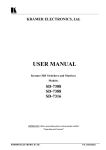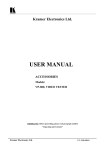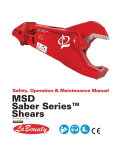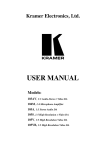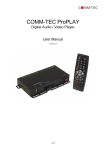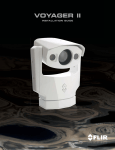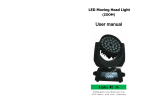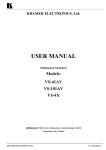Download Kramer Electronics Ltd.
Transcript
Kramer Electronics, Ltd. USER MANUAL Composite - Y/C Transcoders Models: 401C 401D IMPORTANT: Before proceeding, please read paragraph entitled "Unpacking and Contents" KRAMER ELECTRONICS LTD. PN: 2900-009006 Table Of Contents Section 1 1.1 1.2 2 3 4 4.1 5 5.1 5.2 6 6.1 7. 8. 8.1 8.2 8.3 9. 9.1 10 11 11.1 11.2 Name Page INTRODUCTION A Word on Format Interfaces Factors Affecting Quality of Results SPECIFICATIONS HOW DO I GET STARTED? UNPACKING AND CONTENTS Optional Accessories S-VIDEO DA / CONVERTER Getting to Know your 401C Getting to Know your 401D INSTALLATION Rack Munting CONNECTING TO VIDEO DEVICES USING THE MACHINE Turning On the Machine Composite Video / Y/C Distribution Composite to Y/C Decoding TYPICAL APPLICATIONS Interfacing between s-Video (Y/C) and Composite Video TAKING CARE OF YOUR MACHINE TROUBLESHOOTING Power and Indicators Video Signal Limited Warranty 3 3 4 4 5 5 5 6 6 7 8 8 8 8 8 8 8 9 9 10 10 10 11 12 List Of Illustrations Figure 1 2 3 Page 401C Front Panel Features 401D Front Panel Features Interfacing between s-Video (Y/C) and Composite video 6 7 9 List Of Tables Table 1 2 3 Page Factors Affecting Quality of Results 401C Front Panel Features 401D Front Panel Features 4 6 7 Kramer Electronics Ltd. 2 1 INTRODUCTION Congratulations on your purchase of this Kramer Electronics format interface. Since 1981, Kramer has been dedicated to the development and manufacture of high quality video/audio equipment. The Kramer line has become an integral part of many of the best production and presentation facilities around the world. In recent years, Kramer has redesigned and upgraded most of the line, making the best even better. Kramer’s line of professional video/audio electronics is one of the most versatile and complete available, and is a true leader in terms of quality, workmanship, price/performance ratio and innovation. In addition to the Kramer line of high quality format interfaces, such as the one you have just purchased, Kramer also offers a full line of high quality distribution amplifiers, switchers, processors, controllers and computer-related products. This manual includes configuration, operation and option information for the 401C and the 401D. 1.1 A Word on Format Interfaces There are several video signal formats: Composite, Y/C, YUV (Y, R-Y, B-Y), RGB (S) analog and digital. YUV and RGB Component analog video formats are unmodulated signals, where the signal level represents the signal intensity, (e.g., 1 Volt of “Y” signal represents a maximum white level). Converting from YUV to RGB and vice versa does not involve modulation, and requires mainly an accurate matrix system. Composite video and Y/C (Super Video) contains chrominance (color) information, which is a modulated signal using the color subcarrier (3.58MHz in NTSC, 4.43MHz in PAL) as the carrier signal. Converting between Composite video and Y/C involves adding or separating the color information to or from the luminance information. To convert from Composite and Y/C to Component video, a color encoder or color decoder is needed, with very complicated circuitry. The color encoder receives the component signal, and must create a chrominance signal by extracting the blue and red information from the component video signal and modulating this information using the color subcarrier signal. The color decoder does the opposite: it removes the color subcarrier and extracts the color difference signals to create the video “components”. The following format interfaces exist in Kramer’s line: Video Decoders - used to decode (convert) a composite video signal to Y/C and to decode a composite or Y/C signal to RGBS and/or Y, R-Y, B-Y. Video Encoders - used to create a chrominance signal from video components, e.g., to convert RGBS and/or Y, R-Y, and B-Y signals to composite video and Y/C. Video Transcoders - bi-directional converters operating simultaneously in different directions, such as converting from RGBS to Y, R-Y, and B-Y in both directions in the same machine, going from composite to Y/C, bi-directionally or performing color decoding and encoding in the same machine at the same time. Audio Transcoders - used in audio and video production studios for converting from unbalanced low-level audio to balanced high-level audio, bi-directionally. Kramer Electronics Ltd. 3 1.2 Factors Affecting Quality of Results There are many factors affecting the quality of results when signals are transmitted from a source to an acceptor as described in Table 1: Table 1: Factors Affecting Quality of Results FACTOR 2 EFFECT Connection cables Low quality cables are susceptible to interference; they degrade signal quality due to poor matching and cause elevated noise levels. They should therefore be of the best quality. Sockets and connectors of the sources and acceptors So often ignored, they should be of highest quality, since "Zero Ohm" connection resistance is the objective. Sockets and connectors must also match the required impedance (75ohm in video). Cheap, low quality connectors tend to rust, thus causing breaks in the signal path Amplifying circuitry Must have quality performance when the desired end result is high linearity, low distortion and low noise operation Distance between sources and acceptors Plays a major role in the final result. For long distances between sources and acceptors, special measures should be taken in order to avoid cable losses. These include using higher quality cables or adding line amplifiers. Interference from neighboring electrical appliances These can have an adverse effect on signal quality. Balanced audio lines are less prone to interference, but unbalanced audio should be installed far from any mains power cables, electric motors, transmitters, etc. even when the cables are shielded SPECIFICATIONS 401C Function Inputs Outputs Video Bandwidth Nonlinearity Coupling Differential Gain Differential Phase K-Factor Luma S/N Ratio Maximal Input Dimensions (W, D, H) Weight Power Source 401D s-Video DA / Converter 1 s-Video on a 4P connector, Y: 1Vpp/75ohm, C: 0.3Vpp/75ohm. 2 s-Video on 4P connectors, Y: 1Vpp/75ohm, C: 0.3Vpp/75ohm. 1 Composite Video, 1Vpp/75 ohm on BNCs 160 MHz -3dB (Y) <0.05%. AC (CV to YC); DC (YC to YC) <0.05 %. <0.03 Deg. 0.1 % >80 dB. 12 x 7.5 x 2.5 (cm) 4.7" x 2.95" x 0.98" 0.28kg. (0.62 lbs.) Approx. 12VDC, 60 mA. Kramer Electronics Ltd. 4 Composite to Y/C Decoder 1 Composite Video, 1Vpp/75 ohm on a BNC 1 s-Video on a 4P connector, Y: 1Vpp/75ohm, C: 0.3Vpp/75ohm. >3.6 MHz <0.7% <0.45 Deg. >77dB. 1.5Vpp/75 ohm (Y) 12 x 7.5 x 2.5 (cm) 4.7" x 2.95" x 0.98" 0.28kg. (0.62 lbs.) Approx. 12VDC, 70 mA. 3 HOW DO I GET STARTED? The fastest way to get started is to take your time and do everything right the first time. Taking 15 minutes to read the manual may save you a few hours later. You don’t even have to read the whole manual. If a section doesn’t apply to you, you don’t have to spend your time reading it. 4 UNPACKING AND CONTENTS The items contained in your Kramer format interface package are listed below. Please save the original box and packaging materials for possible future shipment. 4.1 Format Interface User Manual DC Power Supply Kramer Concise Product Catalog 4 Rubber Feet Mounting Brackets Optional Accessories The following accessories, which are available from Kramer, can enhance implementation of your machine. For information regarding cables and additional accessories, contact your Kramer dealer. Rack Adapter - Used to install smaller machines in a standard 1U or 3U rack. One or more machines may be installed on each adapter. 105S - (1:5 s-Video distribution amplifier) can be serially connected between the format interface and an acceptor for s-Video distribution. The 105S splits a single s-Video input source into five identical outputs. The 105S uses an external 12VDC power source, and therefore is suitable for fieldwork as well. The 105S uses state of the art technology and microchip design, boasting a signal bandwidth of over 230MHz, thus making it suitable for the most demanding applications. SP-11 - (Video/Audio processor) can be serially connected between the video/audio source and the format interface for video and audio control/correction. The machine provides camera control and luminance/white balance correction. It is also capable of performing composite to Y/C conversion and bi-directional transcoding. The machine allows full control over the video signal: video gain down to full fade, log or linear definition control, log or linear contrast control, color saturation control, black level control, red, green and blue controls and a screen splitter control for “before-after” comparison. The Input switch control is "audio-follow-video". VIDEO TESTER - A new, unique, patented, indispensable tool for the video professional, the Video Tester is used to test a video path leading to/from an amplifier. By pressing only one touch switch it can trace missing signals, distinguish between good and jittery (VCR sourced) signals, and identify the presence of good signals. Whenever a video signal is missing, because of bad connections, cable breaks or faulty sources, the Video Tester is all you need. Kramer Electronics Ltd. 5 5 S-VIDEO DA / CONVERTERS This section describes all the controls and connections of your s-Video DA / Converter. Understanding the controls and connections helps you realize the full power of your machine. 5.1 Getting to Know Your 401C The Kramer 401C combines the functions of a distribution amplifier and encoder into a single compact unit. It accepts one s-Video (Y/C) input and distributes the signal to a total of four outputs, two of which are s-Video, and two that are converted into the composite video format. The 401C is an ideal compatibility solution for presentation systems consisting of display, recording, and routing equipment requiring different signal formats. A power supply is included but the optional VA-50P can power up to six Kramer devices requiring 12VDC. The 401C is part of the Kramer TOOLS family of compact, high quality, cost effective solutions for a variety of applications. Figure 1: 401C Front Panel Features Table 2: 401C Front Panel Features No. 1. 2. 3. 4. 5. Feature COMPOSITE OUT Y/C OUT Y/C IN ON LED 12VDC feed connector Function 2 BNCs for Composite Video outputs. 2 4P connectors for Y/C outputs. A 4P connector for Y/C input. Lights when power is connected. A DC connector that allows power to be supplied to the unit. Kramer Electronics Ltd. 6 5.2 Getting to Know Your 401D The Kramer 401D is a high quality decoder designed to convert composite video into s-Video (Y/C). It is an excellent compatibility solution for many applications in which composite sources need to be interfaced with s-Video compatible displays, switching systems, etc. The 401D has full compensation for Y/C delay, and comes with a 12V power supply. The optional VA-50P can power up to six Kramer devices requiring 12VDC. The 401D is part of the Kramer TOOLS family of compact, high quality, cost effective solutions for a variety of applications. Figure 2: 401D Front Panel Features Table 3: 401D Front Panel Features No. 1 2 3 4 Feature Function Y/C OUT 4P connector for the Y/C output. COMPOSITE IN BNC for Composite Video Input. ON LED Lights when power is connected. 12VDC feed connector DC connector that allows power to be supplied to the unit. Kramer Electronics Ltd. 7 6 INSTALLATION 6.1 Rack Mounting The Kramer 401C and 401D may be rack mounted in a standard 19” (1U) EIA rack assembly, using a special TOOLS Adapter (1U or 3U) and two mounting brackets (see section 4.1). They can be also table mounted using the mounting brackets provided. These devices do not require any specific spacing above or below the unit for ventilation. 7 CONNECTING TO VIDEO DEVICES Video sources and output devices (such as monitors, projectors or recorders) may be connected to the machine through the BNC and/or 4P type connectors located on the back of the unit. Unused inputs are terminated to 75ohm, and active inputs should be terminated by the connecting source. Use cables of equal length for all signal connections that use more than one cable interconnecting between devices. 8 USING THE MACHINE 8.1 Turning on the Machine NOTES 1) The machine should only be turned on after all connections are completed and all source devices have been turned on. Do not attempt to connect or disconnect any video, audio or control signals to the machine while it is turned on! 2) The socket-outlet should be near the equipment and should be easily accessible. To fully disconnect equipment, remove power cord from socket. 1) Connect the power supply provided with the machine to the machine's DC socket. Observe proper polarity! Note that the LED on the panel is illuminated. 2) Operate the source and the acceptors. 8.2 Composite Video / Y/C Distribution (401C) The 401C Encodes the incoming Y/C signal to Composite, and at the same time distributes the incoming Y/C inputs to two outputs, as well as distributing the encoded Composite video signals to two outputs. All outputs may be used simultaneously with no signal degradation. 8.3 Composite to YC Decoding (401D) The 401D decodes the incoming Composite signal to Y/C. The conversion process uses high quality components employing delay correction, resulting in a decoded Y/C signal that is a good as the incoming source, with no apparent image deterioration. Kramer Electronics Ltd. 8 9 TYPICAL APPLICATIONS 9.1 Interfacing between s-Video (Y/C) and Composite video For example, for studio and presentation applications, the 401C can be used for conversion from sVideo (Y/C) to Composite video and at the same time to distribute both types of signals, as follows: 1. Connect an s-Video (Y/C) source to the YC IN connector of the 401C. 2. Connect up to two Y/C acceptors to the Y/C OUT connectors of the 401C (Video projector, Y/C monitor etc.) 3. Connect up to two Composite video acceptors to the COMPOSITE OUT connectors of the 401C (VCRs, Monitors etc.) 4. Connect the 401C to an appropriate 12VDC power supply, with proper polarity. 5. Operate sources, acceptors and the 401C. Figure 3: Interfacing between s-Video (Y/C) and Composite video Kramer Electronics Ltd. 9 10 TAKING CARE OF YOUR MACHINE Do not locate your machine in an environment where it is susceptible to dust or moisture. Both of these may damage the electronics, and cause erratic operation or failure. Do not locate your machine where temperature and humidity may be excessive. Doing so may also damage the electronics, and cause erratic operation or failure of your machine. Do not clean your machine with abrasives or strong cleaners. Doing so may remove or damage the finish, or may allow moisture to build up. Take care not to allow dust or particles to build up inside unused or open connectors. 11 TROUBLESHOOTING NOTES Please note that if the output signal is disturbed or interrupted by very strong external electromagnetic interference, it should return and stabilize when such interference ends. If not, turn the power switch off and on again to reset the machine. If the following recommended actions do not result in satisfactory operation, please consult your KRAMER Dealer. 11.1 Power and Indicators Problem No Power 1. 2. 3. 4. Remedy Confirm that power connections are secured at the machine and at the receptacle. Make sure the receptacle is active, outputting the proper voltage. If there is still no power use a Philips screwdriver to remove screws on both sides of the machine and release the panel. Locate fuse inside your machine. Confirm that the fuse is good by looking for the wire connected between the ends of the fuse. If this wire is broken, replace fuse with another, with the same rating. Install cover and tighten the Philips screws. Kramer Electronics Ltd. 10 11.2 Video Signal Problem No video at the output device Video level is too high or too dim. Noise bars "roll" up or down in the output image or: Low Frequency Hum in the output signal Remedy 1. Confirm that your source and output devices are turned on and connected properly. The input of your machine should be of an identical signal format to the output of your source. Signals at the output of your machine should be of an identical signal format as at the input of your display. 2. Confirm that any other device in the signal path have the proper input and/or output selected. 3. Use the Video Tester to test the video path leading to/from your machine (see section 4.1"Video Tester") 1. Verify that the lines are well matched through 75ohm impedances. 2. Confirm that the connecting cables are of high quality and properly inserted. 3. Check level controls located on your source input device or output display. Hum bars (ground loop) are caused by a difference in the ground potential of any two or more devices connected to your signal path. This difference is compensated by passing that voltage difference through any available interconnection, including your video cables. WARNING! Do not disconnect the ground from any piece of video equipment in your signal path! Check the following to remove hum bars: 1. Confirm that all interconnected equipment is connected to the same phase of power, if possible. 2. Remove equipment connected to that phase that may introduce noise, such as motors, generators, etc. 3. Disconnect all interconnect cables and reconnect them one at a time until ground loop reappears. Disconnect the affected cable and replace, or insert an isolation transformer in the signal path. Kramer Electronics Ltd. 11 LIMITED WARRANTY Kramer Electronics (hereafter Kramer) warrants this product free from defects in material and workmanship under the following terms. HOW LONG IS THE WARRANTY Labor and parts are warranted for three years from the date of the first customer purchase. WHO IS PROTECTED Only the first purchase customer may enforce this warranty. WHAT IS COVERED AND WHAT IS NOT COVERED Except as below, this warranty covers all defects in material or workmanship in this product. The following are not covered by the warranty: 1) Any product which is not distributed by Kramer, or which is not purchased from an authorized Kramer dealer. If you are uncertain as to whether a dealer is authorized, please contact Kramer at one of the agents listed in the web site www.kramerelectronics.com. 2) Any product, on which the serial number has been defaced, modified or removed. 3) Damage, deterioration or malfunction resulting from: a) Accident, misuse, abuse, neglect, fire, water, lightning or other acts of nature. b) Product modification, or failure to follow instructions supplied with the product. c) Repair or attempted repair by anyone not authorized by Kramer. d) Any shipment of the product (claims must be presented to the carrier). e) Removal or installation of the product. f) Any other cause, which does not relate to a product defect. g) Cartons, equipment enclosures, cables or accessories used in conjunction with the product. WHAT WE WILL PAY FOR AND WHAT WE WILL NOT PAY FOR We will pay labor and material expenses for covered items. We will not pay for the following: 1) Removal or installations charges. 2) Costs of initial technical adjustments (set-up), including adjustment of user controls or programming. These costs are the responsibility of the Kramer dealer from whom the product was purchased. 3) Shipping charges. HOW YOU CAN GET WARRANTY SERVICE 1) To obtain service on you product, you must take or ship it prepaid to any authorized Kramer service center. 2) Whenever warranty service is required, the original dated invoice (or a copy) must be presented as proof of warranty coverage, and should be included in any shipment of the product. Please also include in any mailing a contact name, company, address, and a description of the problem(s). 3) For the name of the nearest Kramer authorized service center, consult your authorized dealer. Kramer Electronics Ltd. 12 LIMITATION OF IMPLIED WARRANTIES All implied warranties, including warranties of merchantability and fitness for a particular purpose, are limited in duration to the length of this warranty. EXCLUSION OF DAMAGES Kramer’s liability for any defective products is limited to the repair or replacement of the product at our option. Kramer shall not be liable for: 1) Damage to other property caused by defects in this product, damages based upon inconvenience, loss of use of the product, loss of time, commercial loss; or: 2) Any other damages, whether incidental, consequential or otherwise. Some countries may not allow limitations on how long an implied warranty lasts and/or do not allow the exclusion or limitation of incidental or consequential damages, so the above limitations and exclusions may not apply to you. This warranty gives you specific legal rights, and you may also have other rights, which vary from place to place. NOTE: All products returned to Kramer for service must have prior approval. This may be obtained from your dealer. NOTICE This equipment has been tested to determine compliance with the requirements of: EN-50081: EN-50082: CFR-47 "Electromagnetic compatibility (EMC); generic emission standard. Part 1: Residential, commercial and light industry" "Electromagnetic compatibility (EMC) generic immunity standard. Part 1: Residential, commercial and light industry environment". FCC Rules and Regulations: Part 15- “Radio frequency devices: Subpart B- Unintentional radiators” CAUTION! ⌦ ⌦ ⌦ Servicing the machines can only be done by an authorized Kramer technician. Any user who makes changes or modifications to the unit without the expressed approval of the manufacturer will void user authority to operate the equipment. Use the supplied DC power supply to feed power to the machine. Please use recommended interconnect cables to connect the machine to other components. Kramer Electronics Ltd. 13 The list of Kramer distributors appears on our web site: www.kramerelectronics.com From the web site it is also possible to e-mail factory headquarters. We welcome your questions, comments and feedback. Kramer Electronics Ltd. 3 Am VeOlamo Street. Jerusalem 95463, Israel Tel: (972-2)-654-4000. Fax: (972-2)-653-5369 e-mail: [email protected]














